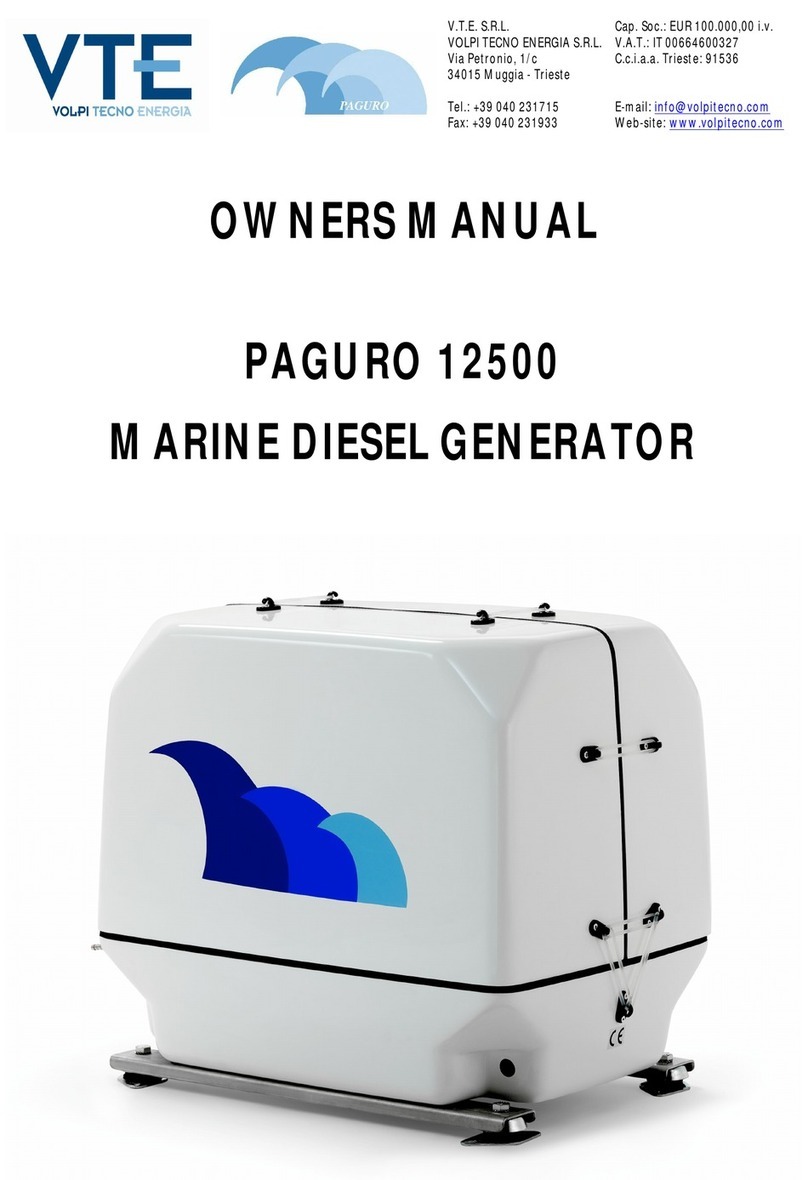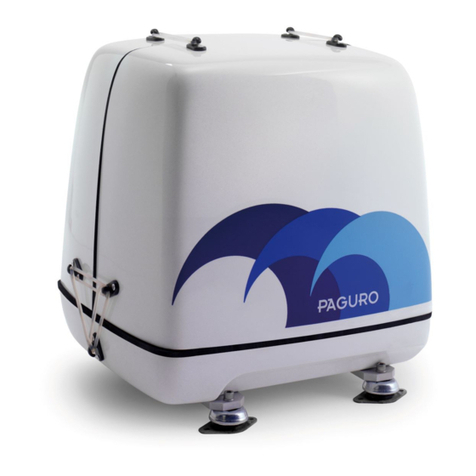
OWNERS MANUAL
PAGURO 2000
TABLE OF CONTENTS
GENERAL INFORMATIONS …………………………………………………………………………………………………………………………….... 3
SAFETY INSTRUCTIONS ………………………………………………………………………………………………………………………………. 5
INTRODUCTIONS / RECOMISSIONINGS ……………………………………………………………………………………………………………… 10
1. INSTALLATION ……………………………………………………………………………………………………………………………………………….. 11
EXTERNAL CONNECTIONS ………………………………………………………………………………………………………………………………. 12
VENTILATION ……………………………………………………………………………………………………………………………………………….. 12
LOCATION AND MOUNTINGS ………………………………………………………………………………………………………………………………. 13
FUEL LINES (Fuel Supply Line, Fuel return Line) …………………………………………………………………………………………..... 13
EXHAUST SYSTEM ………………………………………………………………………………………………………………………………………………… 14
RAW WATER COOLING SYSTEM (Siphon break, Raw Water Intake) …………………………………………………………… 15
INVERTER INSTALLATION ……………………………………………………………………………………………………………………………….. 16
STARTING BATTERY CONNECTION ………………………………………………………………………………………………………………. 16
MAIN OUTPUT VOLTAGE (230 V AC) ………………………………………………………………………………………………………………. 17
CONTROL PANEL ………………………………………………………………………………………………………………………………………………… 18
2. PREPARATION FOR INITIAL START-UP ………………………………………………………………………………………………………………. 22
DIESEL FUEL ………………………………………………………………………………………………………………………………………………… 22
ENGINE OIL SPECIFICATION ……………………………………………………………………………………………………………………………….. 22
PRE-START INSPECTION ……………………………………………………………………………………………………………………………….. 22
3. STARTING/STOPPING PROCEDURE ………………………………………………………………………………………………………………. 23
ELECTRIC START ………………………………………………………………………………………………………………………………………………… 23
PRE-HEATING ………………………………………………………………………………………………………………………………………………… 23
STARTING OPERATION ……………………………………………………………………………………………………………………………….. 23
OPERATING THE GENERATOR ……………………………………………………………………………………………………………………………….. 23
INITIAL START UP CHECK LIST ……………………………………………………………………………………………………………………………….. 23
STOPPING THE GENERATOR ……………………………………………………………………………………………………………………………….. 23
4. BREAK-IN PROCEDURE ……………………………………………………………………………………………………………………………….. 24
CHECK LIST ………………………………………………………………………………………………………………………………………………… 24
STOPPING THE GENERATOR ……………………………………………………………………………………………………………………………….. 24
5. MAINTENANCE SCHEDULE ……………………………………………………………………………………………………………………………….. 25
6. EXHAUST SYSTEM ………………………………………………………………………………………………………………………………………………… 27
EXHAUST SYSTEM PRECAUTIONS ………………………………………………………………………………………………………………. 27
7. COOLING SYSTEM ………………………………………………………………………………………………………………………………………………… 28
RAW WATER PUMP (inspecting/changing the raw water pump impeller) …………………………………………………………… 28
RAW WATER INTAKE STRAINER ……………………………………………………………………………………………………………………………….. 28
8. LUBRICATION SYSTEM ……………………………………………………………………………………………………………………………….. 29
ENGINE OIL ………………………………………………………………………………………………………………………………………………… 29
OIL PRESSURE ………………………………………………………………………………………………………………………………………………… 29
OIL COOLER ………………………………………………………………………………………………………………………………………………… 29
OIL FILTER ……………………………….………………………………………………………………………………………………………………. 29
CHECKING THE OIL ………………………………………………………………………………………………………………………………………………… 29
CHANGING THE OIL ………………………………………………………………………………………………………………………………………………… 29
DRAINING THE USED OIL ……………………………………………………………………………………………………………………………….. 29
ADDING NEW OIL ………………………………………………………………………………………………………………………………………………… 30
9. FUEL SYSTEM ………………………………………………………………………………………………………………………………………………... 30
DIESEL FUEL ………………………………………………………………………………………………………………………………………………… 30
FUEL ADDITIVES ………………………………………………………………………………………………………………………………………………… 30
CARE OF THE FUEL SUPPLY ……………………………………………………………………………………………………………………………….. 30
FUEL LIFT PUMP ………………………………………………………………………………………………………………………………………………… 30
FUEL FILTER ……………………………………..…………………………………………………………………………………………………………. 30
FUEL SUPPLY LINE ………………………………………………………………………………………………………………………………………………... 31
FUEL FILTER OF THE WATER-SEPARATING TYPE ……………………………………………………………………………………………... 31
FUEL INJECTION PUMP ……………………………………………………………………………………………………………………………….. 31
FUEL SHUT-OFF SOLENOID ……………………………………………………………………………………………………………………………….. 31
BLEEDING THE FUEL SYSTEM ……………………………………………………………………………………………………………………………….. 31
SPARE PARTS ………………………………………………………………………………………………………………………………………………... 31
10. ENGINE TROUBLESHOOTING ……………………………………………………………………………………………………………………………..... 32
11. DC ELECTRICAL SYSTEM ……………………………………………………………………………………………………………………………….. 33
12 VOLT DC CONTROL CIRCUIT ……………………………………………………………………………………………………………………………….. 33
BATTERY (Battery Care, Checking the service Battery) ……………………………………………………………………………………………… 33
ELECTRICAL SCHEME ………………………………………………………………………………………………………………………………………………... 34
12. GENERATOR INFORMATION ……………………………………………………………………………………………………………………………….. 35
GENERATOR MAINTENANCE ……………………………………………………………………………………………………………………………….. 35
13. GENERATOR TROUBLESHOOTING ………………………………………………………………………………………………………………. 35
14. SHORE POWER TRANSFER SWITCH ………………………………………………………………………………………………………………. 36
15. LAY UP AND RECOMISSIONING ……………………………………………………………………………………………………………………………….. 37






























